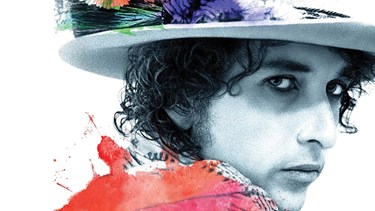
Rolling Thunder Revue is playing at the Paris Theater, along with a Bob Dylan film series, from June 2 through 6.
It was only two years ago (though it seems longer) that the release of Rolling Thunder Revue: A Bob Dylan Story aroused complaints from viewers claiming that Martin Scorsese’s injection of imaginary sidebars to Dylan’s actual 1975-6 Rolling Thunder tour was somehow analogous to the “fake news” ethos simultaneously abetted and assailed by the Far Right. Such reactions made one wonder whether meta-fiction itself had become a causality of the Trump era. Why get all itchy and puffed-up about a movie that, after all, shows its hand at the outset? If you can’t tell from Scorsese’s opening image of a magic act that his movie is being up front with its forthcoming mischief, that’s on you, not on Scorsese, and not on Dylan.
One may disagree with the latter’s typically gnomic pronouncement that wearing a mask is a means of telling the truth. (As with much else with Dylan, he borrowed that observation from someone else; Oscar Wilde, in this case.) But the movie’s sly tomfoolery is altogether consistent with a rock music tour whose gypsy-caravan concept was steeped in shadows, disguise and craftiness. The tour’s leader, after all, chose to wear whiteface and the sundry mix of touring musicians and guest artists—Joan Baez, Scarlet Rivera, Roger McGuinn, Ronee Blakely, Joni Mitchell, Mick Ronson, T. Bone Burnett, and Allen Ginsberg among others —seemed like pop-up apparitions. So it’s almost too tempting for artists as impulsively subversive as Scorsese and Dylan to weave into this “true” story a couple of whoppers like the one featuring a “younger” Sharon Stone as a teenage groupie or Michael Murphy, wearing his Jack Tanner persona from the Robert Altman’s faux HBO “campaign documentary” Tanner ’88, pretending to be Jimmy Carter’s advance man for the latter’s nascent presidential run. (Anybody who saw Altman’s Nashville earlier in 1975 may also feel their ribs nudged with memories of the Hal Phillip Walker campaign where Murphy also did “advance work.”) All these run-amok spins on reality may rankle the literal-minded, but, for me at least, the movie’s willingness to tease at the parameters of literal and figurative storytelling offer magical release from mundane, stifling realities.
I remember going to a November 1975 Rolling Thunder gig at the Hartford Civic Center deep in the doldrums of economic blight, especially in down-and-depressed New England, and coming away from the show feeling buoyed and even cross-eyed hopeful about the immediate future. Which is sort of how I felt when this movie was over as Trump-ism and its rampant polarizations roared on all around me. I can’t explain why in concrete detail, but I suspect it may have something to do with what Allen Ginsberg is telling us all to do at the end of this film: “You who saw it all or who saw flashes and fragments, take from us some example, try and get yourselves together, clean up your act, find your community, pick up on some kind of redemption of your own consciousness, become mindful of your own friends, your own work, your own proper meditation, your own art, your own beauty, go out and make it for your own Eternity.”
Abracadabra…and Amen!
Gene Seymour is a cultural critic who writes regularly for CNN Opinion, and has written for Newsday, The Nation, The Washington Post and numerous publications.
